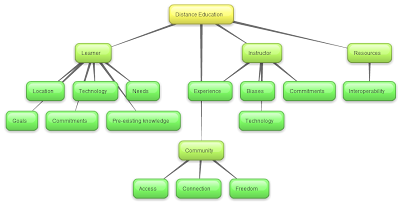Old Definition:
Learning activities where the instructor and learner are not interacting within the same physical space at the same time is what I would say was my personal definition of distance learning prior to completing the readings this week. This includes paper-based correspondence courses where communications are sent back and forth by mail, distance education courses, corporate training done in a self-study or webinar format as well as coaching that may be done by phone or through other media. It includes all formal and informal learning that occurs in this manner.
When Dr. Simonson described “Distance Education” in the video this week, he defined it as “Formal education in which the learning group (teacher, students, resources) are separated by geography and, sometimes by time (Simonson, n.d.) . It includes both “distance teaching” and “distance learning”. So in this context, “distance learning” is a part of “distance education”, but not synonymous. When I review my original definition, I can see that there is a collapse between “distance teaching” and “distance learning”. I don’t think that the mediums add any value to the definition either, as they are not 100% inclusive and I don’t believe that informal learning belongs in this definition either.
Revised Definition:
My revised definition of distance education would now be:
Formal learning activities that occur where there is a distance between the learner and the source of the instruction.
Future Evolution:
As distance learning continues to evolve, I think that ultimately, learner preferences will move more to the forefront. I see a significant shift occurring (which has already started) where learner needs and desires move to the forefront, over those of instructors or institutions. This will include considerations on the “when and where” that Simonson et. al (2009) speaks to. The mediums of the future will be learner driven. Those that don’t suit learners will die out – and those that are preferred will thrive. Learners will continue to become more sophisticated as consumers of learning, and there will be less and less tolerance for poor quality as the field becomes more competitive and learner driven. I also see “community” taking a larger role than it currently does, with more teaching and learning occurring through that vehicle than in the more formal structure that we are used to.
References:
Distance Education: The Next Generation [Video]. (n.d.)
Distance Education: The Next Generation [Video]. (n.d.)
Simonson, M., Smaldino, S., Albright, M., & Zvacek, S. (2009). Teaching and learning at a distance: Foundations of distance education (4th ed.) Boston, MA: Pearson.

Hello I have subscribed to your blog.
ReplyDeleteLaKeisha McClendon